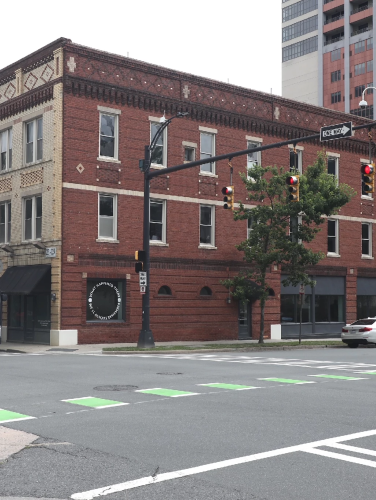
Mecklenburg Investment Company
(ca. 1922)
The first office building in Charlotte built exclusively by and for Black professionals and businessmen.
223 S. Brevard St., Charlotte, NC 28202
The Mecklenburg Investment Company (MIC) formed in May 1921 to finance the construction of an office building in the Brooklyn neighborhood of Charlotte’s Second Ward. Built as an anchor for the neighborhood’s business and social activities, the building was the first structure planned and executed by Black community leaders to accommodate Black businesses, professional offices, and civic and fraternal organizations. The MIC shareholders represented a new middle class of urban Blacks that emerged across the South after World War I – educated, prosperous, and self-reliant – and included prominent local doctors, dentists, lawyers, faculty members of the nearby Johnson C. Smith University, and other professionals and businessmen.
Property Quick Links
The MIC president, Winnsboro, South Carolina native Caesar Robert Blake, Jr. (1886-1931), worked as a real estate broker and clerk with Norfolk and Southern Railway. Active in several fraternal societies, Blake served for twelve years as the Imperial Potentate of the Ancient Egyptian Arabic Order of the Nobles of the Mystic Shrine (A.E.A.O.N.M.S.), also known as the Prince Hall Shriners. In that role he helped lead a successful legal defense before the U.S. Supreme Court against the predominately White Knights of Pythias who sought to end Black Masonic fraternities with claims of fraud and copyright violations in A.E.A.O.N.M.S. v. Michaux (1929). Thad L. Tate (1865-1951) – longtime owner of the Uptown Barber Shop and director of the Mechanics' Perpetual Building and Loan Company – served as MIC’s treasurer. Through Tate’s efforts as a civic leader, Black Charlotteans gained the Public Library’s Brevard Street branch, Grace A.M.E. Zion Church, and a local YMCA branch. MIC’s Board of Directors included Dr. John Taylor Williams (1859-1924), a prominent and respected educator, physician, businessman and public servant. In 1882, Williams ended his career as an educator – which included establishing Charlotte’s first school for Black children – to enter medical school at Raleigh’s Shaw University. As one of the first three Black physicians licensed to practice medicine in North Carolina, Williams returned to Charlotte to build a prosperous surgical practice and drug company. His distinguished public service included an appointment by President William McKinley as consul to Sierra Leone (1898-1907).
MIC retained another local Black professional, William W. Smith (1873-1924), to construct the building. Starting his career as a brick mason, Smith became a talented designer and builder whose work included the Grace A.M.E. Zion Church that once stood on the same block as the MIC building. The original plans of the building included six stores on the first floor, sixteen offices on the second, and four offices and an assembly room on the top floor, all at an estimated cost of $28,000. Upon its completion, the building attracted numerous Black professionals and businessmen whose prior offices were scattered about the city. For nearly forty years, before the Urban Renewal campaigns of the 1960s and 1970s laid waste to the Second Ward community, the building served as a center for social, business, and professional activities for Charlotte's Black citizens, including Yancey's Drug Store, the Savoy Inn restaurant, and several of Charlotte's Black Masonic lodges and social clubs. The MIC building is one of the few remaining structures from Second Ward’s Brooklyn neighborhood.

